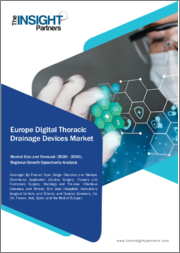
|
시장보고서
상품코드
1374796
세계의 흉강 배액 기기 시장(2023-2030년)Global Thoracic Drainage Devices Market -2023-2030 |
||||||
개요
최소침습적 흉강 배액술을 선호하는 환자들의 최소침습적 흉강 배액술로의 전환과 같은 추세는 세계 흉강 배액 기기 시장을 주도할 것으로 예상됩니다.
세계 흉강 배액 기기 시장은 최근 몇 년 동안 크게 성장해 왔으며 앞으로도 계속 상승세를 이어갈 것으로 예상됩니다. 시장은 변화의 시기를 맞이하고 있으며, 환자의 실시간 모니터링, 원격 데이터 액세스, 환자 관리 개선을 위한 연결 기능을 갖춘 흉강 배액 시스템의 디지털화 등 몇 가지 중요한 트렌드의 영향을 받고 있습니다.
또한, 흉부 질환의 유병률 증가, 흉강 배액 기기의 지속적인 기술 발전으로 인한 효율성 및 안전성 향상, 폐 절제술 및 이식 등 흉부 수술의 증가로 인해 흉강 배액 기기가 필요한 수술이 증가함에 따라 흉강 배액 기기 시장 규모가 확대되고 있습니다. 새로운 기술에 대한 연구 활동이 활발해지고, ATMOS MedizinTechnik GmbH & Co.K, Becton, Dickinson and Company 및 기타 기업들이 시장에서 활발하게 활동하고 있는 것도 북미 지역의 수요 요인 중 하나입니다. 있습니다.
다이나믹스
흉부 수술 건수 증가로 흉강 배액 기기 시장 성장 견인
흉부 수술 건수의 증가는 흉강 배액 기기 시장을 주도하는 중요한 요인입니다. 흉강 배액 기기는 심막강과 흉막강에서 혈액, 체액 및 공기를 배출하여 수술 후 문제를 줄이고 흉수, 탐포나드, 기흉, 출혈과 같은 문제를 최소화할 수 있기 때문에 흉부 외과 수술에 필수적입니다. 개선된 디지털 배액 장치가 개발되기 전에는 지난 50년 동안 고전적인 3실 흡인법이 흉부 수술의 표준이었습니다.
예를 들어, 2022년 발표된 미국 국립의학도서관 논문에 따르면, 미국에서만 약 4,000명의 흉부외과 의사가 연간 약 53만 건의 일반 흉부외과 수술을 시행하고 있으며, 대부분 남성(92%)이며, 평균 연령은 56세다. 평균 흉부외과 의사는 연간 135명의 환자를 수술합니다. 이러한 흉부 수술의 증가는 환자 치료 및 치료 결과 개선에 대한 시장의 성장 잠재력을 강조하고 있습니다.
기술 발전으로 흉강 배액 기기 시장 성장 촉진
고급 설계를 포함하는 흉강 배액 기기의 발전이 확대되면서 시장을 견인할 것으로 예상됩니다. 예를 들어, 2023년 9월 Merit Medical Systems, Inc.는 재발성 및 증상성 흉수(폐 외부에 고여 있는 체액)와 악성 복수(암으로 인해 복부에 고여 있는 체액)를 치료하는 데 사용되는 Aspira Evacuated Drainage Bottle을 출시하였습니다. 암으로 인해 복부에 고여 있는 체액)의 치료에 사용됩니다.
또한, 아스피라 배액 시스템의 적응증인 재발성 흉수와 악성 복수의 배액은 모두 병원 내 배액이 필요한 경우가 많으며, 이는 최첨단 배액 기술이 환자 치료와 삶의 질을 향상시키는 데 중요한 역할을 한다는 것을 보여줍니다. 따라서 더 많은 의료 기관과 전문가들이 최첨단 솔루션을 채택함에 따라 흉강 배액 기기 시장은 예측 기간 동안 효율성, 정확성 및 환자 결과를 개선하는 기술 개선에 힘입어 성장할 것으로 예상됩니다.
숙련된 전문가 부족이 시장 성장을 저해
숙련된 전문가의 부족은 이 시장의 주요 억제요인입니다. 흉강 배액술은 다학제적 협력이 필요한 고도의 수술이며, 간호사는 흉강관 삽입 및 관리에서 중요한 역할을 합니다. 그러나 레지던트가 삽입하는 흉강관에는 많은 문제가 있어 추가 훈련의 필요성이 강조되고 있습니다.
또한 흉강관 삽입은 방사선과 의사, 폐 전문의, 흉부외과 의사가 수행하는 일반적인 시술입니다. 북미방사선학회(Radiological Society of North America) 2022에 따르면, 유럽에는 인구 10만 명당 13명의 방사선과 전문의가 있지만 영국에는 인구 10만 명당 8.5명에 불과해 영국에는 방사선과 전문의가 부족합니다. 따라서 예측 기간 동안 시장이 성장할 것으로 예상됩니다.
목차
제1장 조사 방법과 조사 범위
제2장 정의와 개요
제3장 주요 요약
제4장 시장 역학
- 영향요인
- 성장 촉진요인
- 흉부외과 수술 증가
- 기술 진보
- 성장 억제요인
- 숙련된 전문가 부족
- 기회
- 영향 분석
- 성장 촉진요인
제5장 산업 분석
- Porter's Five Forces 분석
- 공급망 분석
- 가격 분석
- 규제 분석
제6장 COVID-19 분석
제7장 제품별
- 흉강 배액 시스템
- 워터 씰 체스트 배액 시스템
- 드라이 씰 체스트 배액 시스템
- 디지털식 흉강 배액 시스템
- 흉강 배액 키트
- 흉강 배액 카테터
- 흉강천자 카테터
- 복수천자 카테터
- 기타
- 투관침 배액
- 기타
제8장 재료 유형별
- 실리콘
- 폴리우레탄
- 라텍스
- 기타
제9장 용도별
- 심장외과
- 종양학·통증 관리
- 흉부외과·호흡기 내과
- 일반 집중 치료 응급의료
- 기타
제10장 최종사용자별
- 병원
- 외래 수술 센터
- 심장 전문 클리닉
- 심장외과 센터
- 기타
제11장 지역별
- 북미
- 미국
- 캐나다
- 멕시코
- 유럽
- 독일
- 영국
- 프랑스
- 스페인
- 이탈리아
- 기타 유럽
- 남미
- 브라질
- 아르헨티나
- 기타 남미
- 아시아태평양
- 중국
- 인도
- 일본
- 호주
- 기타 아시아태평양
- 중동 및 아프리카
제12장 경쟁 상황
- 경쟁 시나리오
- 시장 상황/점유율 분석
- M&A 분석
제13장 기업 개요
- ATMOS MedizinTechnik GmbH & Co. K
- 기업 개요
- 제품 포트폴리오와 설명
- 재무 개요
- 주요 발전
- Becton, Dickinson and Company
- Cardinal Health.
- Cook Group Incorporated
- Getinge AB
- Sinapi Biomedical
- Teleflex Incorporated
- Utah Medical Products, Inc.
- Vygon SA
- Sterimed Group
제14장 부록
ksm 23.11.16Overview
The trend such as the shift towards minimal invasive thoracic drainage procedures driven by patient preference for less invasive techniques is expected to dominate the global thoracic drainage devices market.
The global thoracic drainage devices market has grown significantly in recent years and is projected to continue on its upward trend. The market is undergoing a transformational period, influenced by several significant trends such as digitalization in chest drainage systems equipped with connectivity features allowing real-time monitoring of patients, remote data access, and improved patient management.
Furthermore, the rising prevalence of thoracic diseases, Continuous technological advancements in thoracic drainage devices have improved their efficiency and safety and increasing number of thoracic surgeries, including lung resections and transplantations, that requires thoracic drainage devices for post-operative care are driving up the thoracic drainage devices market size. The growing research activities for new technologies and presence of establish pharmaceutical medtech companies are some of the factors in demand from North American regions. With significant competitors like ATMOS MedizinTechnik GmbH & Co. K, Becton, Dickinson and Company, and others actively operating in the market.
Dynamics
The Increasing Number of Thoracic Surgeries to Drive the Growth of the Thoracic Drainage Devices Market
The increasing number of thoracic surgeries is an important factor driving in the market for thoracic drainage devices. These devices are essential in cardiothoracic surgery because they allow for the drainage of blood, fluids, and air from the pericardial and pleural cavities, reducing post-operative problems and minimizing concerns such as effusions, tamponade, pneumothoraces, and hemorrhage. Prior to the development of improved digital drainage devices, the classic 3-chamber suction technique was the standard in thoracic surgery for the past five decades.
For instance, according to a National Library of Medicine article published in 2022, states that about 530,000 general thoracic surgery cases are performed annually in the U.S alone by approximately 4,000 cardiothoracic surgeons, the majority of them are male (92%), with an average age of 56 years. The average thoracic surgeon performs 135 patients per year. This increase in thoracic procedures emphasizes the market's potential for growth in enhancing patient care and outcomes.
The Advancements in Technologies will Drive the Thoracic Drainage Devices Market Growth
The growing advancements in thoracic drainage devices emcompassing advanced design is expected to drive the market. For instance, in September 2023, Merit Medical Systems, Inc. announced the launch of its Aspira Evacuated Drainage Bottle. The Aspira Drainage System is used to treat recurring and symptomatic pleural effusions (fluid buildup outside the lungs) and malignant ascites (fluid buildup in the abdomen caused by cancer).
Furthermore, the indications for the Aspira Drainage System for draining recurrent pleural effusions and malignant ascites, both of which frequently require in-hospital drainage, show the crucial role of cutting-edge drainage technologies in improving patient care and quality of life. Thus, as more healthcare organizations and professionals adopt cutting-edge solutions, the market for thoracic drainage devices is expected to grow, fueled by technological improvements that improve efficiency, precision, and patient outcomes over the forecast period.
The Lack of Availability of Skilled Professional Will Hamper the Growth of the Market
The lack of availability of skilled professional is the major restraint for this market. Thoracic drainage is an advanced surgical procedure that requires interdisciplinary collaboration, and nurses play a significant role in chest tube insertion and care. However, chest tubes inserted by resident physicians are frequently associated with problems, emphasizing the need for further training.
Furthermore, chest tube insertion is a common procedure performed by radiologists, pulmonary specialists, and thoracic surgeons. According to the Radiological Society of North America 2022 article, there is a shortage of radiologists in the U.K, since Europe has 13 radiologists per 100,000 people, but the rate in the U.K. is only 8.5 per 100,000. Thus, owing to this factor the market is expected to grow over the forecast period.
Segment Analysis
The global thoracic drainage devices market is segmented based on product, material type, application, end user and region.
Owing to the Better Effectiveness and Variety, the Chest Drainage Systems Segment Accounted for Approximately 47.2% of the Thoracic Drainage Devices Market Share
The chest drainage systems segment is expected to dominate the thoracic drainage device market. These systems are widely used in a variety of clinical settings, including cardiac surgery, cardiothoracic surgery, pulmonology, and critical care, to treat diseases such as pleural effusion, pneumothorax, hemothorax, and post-operative drainage.
This segment's is dominated due to the variety and effectiveness of chest drainage devices in removing air and fluids from the pleural area, hence aiding lung re-expansion and reducing problems. Furthermore, contemporary technological advancements in digital chest drainage systems, which allow for real-time monitoring and enhanced patient management, contribute to their widespread acceptability.
For instance, in July 2022, Centese, Inc. announced the first peer-reviewed study for its Thoraguard digital drainage system for cardiac surgery at Stanford University Medical Center, which was published in the Journal of Thoracic and Cardiovascular Surgery Open. Thoraguard is the first and only digital chest tube management system that delivers automated clog removal without human intervention while continuously and precisely monitoring vital physiological indicators to support clinical decision-making and enhance outcomes. Furthermore, when utilized during heart surgery, Thoraguard was demonstrated to be safe and efficacious when compared to standard analog chest tubes. Thus, owing to the above factors the segment is expected to dominate over the forecast period.
Geographical Penetration
North America Accounted for Approximately 38.2% of the Market Share in 2022, Owing to the Increasing Number of Clinical Trials
The increasing number of clinical trials in North America is expected to dominate the thoracic drainage device market. Clinical trials play a vital role in determining the safety and efficacy of novel devices. For instance, the University of Oklahoma is conducting a clinical trial comparing the Digital Chest Tube Drainage System (Thopaz + ) to the Analog in Pediatric Patients." The purpose of the research is to assess the efficacy of digital (Thopaz + ) and analog (Pleur-evac) drainage devices in pediatric patients. The trial is an interventional, randomized, and controlled study that is expected to enroll 140 people.
Furthermore, the study is expected to be finished by April 1, 2024 and there have been no prospective randomized controlled trials comparing digital versus analog chest tube drainage systems in pediatric patients so far. This will be the first prospective randomized trial to look into the possible benefits of adopting a digital chest tube drainage system in pediatric patients.
Moreover, the increasing prevalence of chronic diseases in North America is also expected to drive the market. Chronic diseases such as heart disease and pulmonology disease are significant drivers of demand for thoracic drainage devices. As the population ages and lifestyle factors increase the prevalence of chronic diseases, the need for appropriate thoracic drainage treatments grows. Thus, owing to the above factors the region is expected to dominate over the forecast period.
Competitive Landscape
The major global players in the thoracic drainage devices market include: ATMOS MedizinTechnik GmbH & Co. K, Becton, Dickinson and Company, Cardinal Health., Cook Group Incorporated, Getinge AB, Sinapi Biomedical, Teleflex Incorporated, Utah Medical Products, Inc., Vygon SA, Sterimed Group, and among others.
COVID-19 Impact Analysis
The World Health Organization (WHO) reported more roughly 585.0 million confirmed COVID-19 cases as of August 2022, with around 6.4 million recorded deaths. However, research has shown that thoracic drainage systems play an important role in preventing the widespread development of COVID-19. Individuals with COVID-19 are at a higher risk of having acute respiratory distress syndrome (ARDS), which requires invasive mechanical ventilation.
Furthermore, COVID-19-related barotrauma frequently results in pneumothorax, necessitating chest tube insertion (thoracostomy). Furthermore, members of the German Health Alliance (GHA), which include prominent companies such as B. Braun, ATMOS MedizinTechnik GmbH & Co. KG, Getinge, and Drager, have seen a significant increase in global demand for their products, particularly thoracic drainage systems, since the beginning of 2020. ATMOS MedizinTechnik GmbH & Co. KG, for example, an innovative medical device maker, has increased production to meet increased demand, realizing that product categories such as drainage systems play a critical role in saving lives in the face of the COVID-19 epidemic.
Key Developments
- On April 18, 2022, Merit Medical Systems, Inc., a global leader in the manufacture and marketing of healthcare technologies, stated the launch of the ReSolve Thoracostomy Tray. The new tray includes everything needed to execute a thoracostomy, a minimally invasive method that allows patients to avoid open surgery to drain fluids or air from the chest.
- On December 15, 2020, Medela LLC stated that their Thopaz + Digital Chest Drainage and Monitoring System completed various quantitative tests demonstrating that its filtration system efficiently inhibits the passage of aerosolized viral particles such as SARS-CoV-2, the virus responsible for COVID-19.
Why Purchase the Report?
- To visualize the global thoracic drainage devices market segmentation based on product, material type, application, end user and region as well as understand key commercial assets and players.
- Identify commercial opportunities by analyzing trends and co-development.
- Excel data sheet with numerous data points of thoracic drainage devices market-level with all segments.
- PDF report consists of a comprehensive analysis after exhaustive qualitative interviews and an in-depth study.
- Product mapping is available in excel consisting of key products of all the major players.
The global thoracic drainage devices market report would provide approximately 53 tables, 54 figures and 195 Pages.
Target Audience 2023
- Manufacturers/ Buyers
- Industry Investors/Investment Bankers
- Research Professionals
- Emerging Companies
Table of Contents
1. Methodology and Scope
- 1.1. Research Methodology
- 1.2. Research Objective and Scope of the Report
2. Definition and Overview
3. Executive Summary
- 3.1. Snippet by Product
- 3.2. Snippet by Material Type
- 3.3. Snippet by Application
- 3.4. Snippet by End-User
- 3.5. Snippet by Region
4. Dynamics
- 4.1. Impacting Factors
- 4.1.1. Drivers
- 4.1.1.1. The Increasing Number of Thoracic Surgeries
- 4.1.1.2. The Advancements in Technologies
- 4.1.2. Restraints
- 4.1.2.1. The Lack of Availability of Skilled Professional
- 4.1.3. Opportunity
- 4.1.4. Impact Analysis
- 4.1.1. Drivers
5. Industry Analysis
- 5.1. Porter's 5 Forces Analysis
- 5.2. Supply Chain Analysis
- 5.3. Pricing Analysis
- 5.4. Regulatory Analysis
6. COVID-19 Analysis
- 6.1. Analysis of COVID-19
- 6.1.1. Scenario Before COVID-19
- 6.1.2. Scenario During COVID-19
- 6.1.3. Scenario Post COVID-19
- 6.2. Pricing Dynamics Amid COVID-19
- 6.3. Demand-Supply Spectrum
- 6.4. Government Initiatives Related to the Market During Pandemic
- 6.5. Manufacturers Strategic Initiatives
- 6.6. Conclusion
7. By Product
- 7.1. Introduction
- 7.1.1. Market Size Analysis and Y-o-Y Growth Analysis (%), By Product
- 7.1.2. Market Attractiveness Index, By Product
- 7.2. Chest Drainage Systems*
- 7.2.1. Introduction
- 7.2.2. Market Size Analysis and Y-o-Y Growth Analysis (%)
- 7.2.2.1. Water Seal Chest Drainage Systems
- 7.2.2.2. Dry Seal Chest Drainage Systems
- 7.2.2.3. Digital Chest Drainage Systems
- 7.3. Thoracic Drainage Kits
- 7.4. Pleural Drainage Catheters
- 7.4.1. Thoracentesis Catheters
- 7.4.2. Paracentesis Catheters
- 7.4.3. Others
- 7.5. Trocar Drains
- 7.6. Others
8. By Material Type
- 8.1. Introduction
- 8.1.1. Market Size Analysis and Y-o-Y Growth Analysis (%), By Material Type
- 8.1.2. Market Attractiveness Index, By Material Type
- 8.2. Silicone*
- 8.2.1. Introduction
- 8.2.2. Market Size Analysis and Y-o-Y Growth Analysis (%)
- 8.3. Polyurethane
- 8.4. Latex
- 8.5. Other
9. By Application
- 9.1. Introduction
- 9.1.1. Market Size Analysis and Y-o-Y Growth Analysis (%), By Application
- 9.1.2. Market Attractiveness Index, By Application
- 9.2. Cardiac Surgery*
- 9.2.1. Introduction
- 9.2.2. Market Size Analysis and Y-o-Y Growth Analysis (%)
- 9.3. Oncology & Pain Management
- 9.4. Thoracic Surgery & Pulmonology
- 9.5. General Intensive Care Emergency Medicine
- 9.6. Others
10. By End-User
- 10.1. Introduction
- 10.1.1. Market Size Analysis and Y-o-Y Growth Analysis (%), By End-User
- 10.1.2. Market Attractiveness Index, By End-User
- 10.2. Hospitals*
- 10.2.1. Introduction
- 10.2.2. Market Size Analysis and Y-o-Y Growth Analysis (%)
- 10.3. Ambulatory Surgery Centers
- 10.4. Cardiac Specialty Clinics
- 10.5. Cardiothoracic Centers
- 10.6. Others
11. By Region
- 11.1. Introduction
- 11.1.1. Market Size Analysis and Y-o-Y Growth Analysis (%), By Region
- 11.1.2. Market Attractiveness Index, By Region
- 11.2. North America
- 11.2.1. Introduction
- 11.2.2. Key Region-Specific Dynamics
- 11.2.3. Market Size Analysis and Y-o-Y Growth Analysis (%), By Product
- 11.2.4. Market Size Analysis and Y-o-Y Growth Analysis (%), By Material Type
- 11.2.5. Market Size Analysis and Y-o-Y Growth Analysis (%), By Application
- 11.2.6. Market Size Analysis and Y-o-Y Growth Analysis (%), By End User
- 11.2.7. Market Size Analysis and Y-o-Y Growth Analysis (%), By Country
- 11.2.7.1. U.S.
- 11.2.7.2. Canada
- 11.2.7.3. Mexico
- 11.3. Europe
- 11.3.1. Introduction
- 11.3.2. Key Region-Specific Dynamics
- 11.3.3. Market Size Analysis and Y-o-Y Growth Analysis (%), By Product
- 11.3.4. Market Size Analysis and Y-o-Y Growth Analysis (%), By Material Type
- 11.3.5. Market Size Analysis and Y-o-Y Growth Analysis (%), By Application
- 11.3.6. Market Size Analysis and Y-o-Y Growth Analysis (%), By End User
- 11.3.7. Market Size Analysis and Y-o-Y Growth Analysis (%), By Country
- 11.3.7.1. Germany
- 11.3.7.2. U.K.
- 11.3.7.3. France
- 11.3.7.4. Spain
- 11.3.7.5. Italy
- 11.3.7.6. Rest of Europe
- 11.4. South America
- 11.4.1. Introduction
- 11.4.2. Key Region-Specific Dynamics
- 11.4.3. Market Size Analysis and Y-o-Y Growth Analysis (%), By Product
- 11.4.4. Market Size Analysis and Y-o-Y Growth Analysis (%), By Material Type
- 11.4.5. Market Size Analysis and Y-o-Y Growth Analysis (%), By Application
- 11.4.6. Market Size Analysis and Y-o-Y Growth Analysis (%), By End User
- 11.4.7. Market Size Analysis and Y-o-Y Growth Analysis (%), By Country
- 11.4.7.1. Brazil
- 11.4.7.2. Argentina
- 11.4.7.3. Rest of South America
- 11.5. Asia-Pacific
- 11.5.1. Introduction
- 11.5.2. Key Region-Specific Dynamics
- 11.5.3. Market Size Analysis and Y-o-Y Growth Analysis (%), By Product
- 11.5.4. Market Size Analysis and Y-o-Y Growth Analysis (%), By Material Type
- 11.5.5. Market Size Analysis and Y-o-Y Growth Analysis (%), By Application
- 11.5.6. Market Size Analysis and Y-o-Y Growth Analysis (%), By End User
- 11.5.7. Market Size Analysis and Y-o-Y Growth Analysis (%), By Country
- 11.5.7.1. China
- 11.5.7.2. India
- 11.5.7.3. Japan
- 11.5.7.4. Australia
- 11.5.7.5. Rest of Asia-Pacific
- 11.6. Middle East and Africa
- 11.6.1. Introduction
- 11.6.2. Key Region-Specific Dynamics
- 11.6.3. Market Size Analysis and Y-o-Y Growth Analysis (%), By Product
- 11.6.4. Market Size Analysis and Y-o-Y Growth Analysis (%), By Material Type
- 11.6.5. Market Size Analysis and Y-o-Y Growth Analysis (%), By Application
- 11.6.6. Market Size Analysis and Y-o-Y Growth Analysis (%), By End User
12. Competitive Landscape
- 12.1. Competitive Scenario
- 12.2. Market Positioning/Share Analysis
- 12.3. Mergers and Acquisitions Analysis
13. Company Profiles
- 13.1. ATMOS MedizinTechnik GmbH & Co. K*
- 13.1.1. Company Overview
- 13.1.2. Product Portfolio and Description
- 13.1.3. Financial Overview
- 13.1.4. Key Developments
- 13.2. Becton, Dickinson and Company
- 13.3. Cardinal Health.
- 13.4. Cook Group Incorporated
- 13.5. Getinge AB
- 13.6. Sinapi Biomedical
- 13.7. Teleflex Incorporated
- 13.8. Utah Medical Products, Inc.
- 13.9. Vygon SA
- 13.10. Sterimed Group
LIST NOT EXHAUSTIVE
14. Appendix
- 14.1. About Us and Services
- 14.2. Contact Us



















